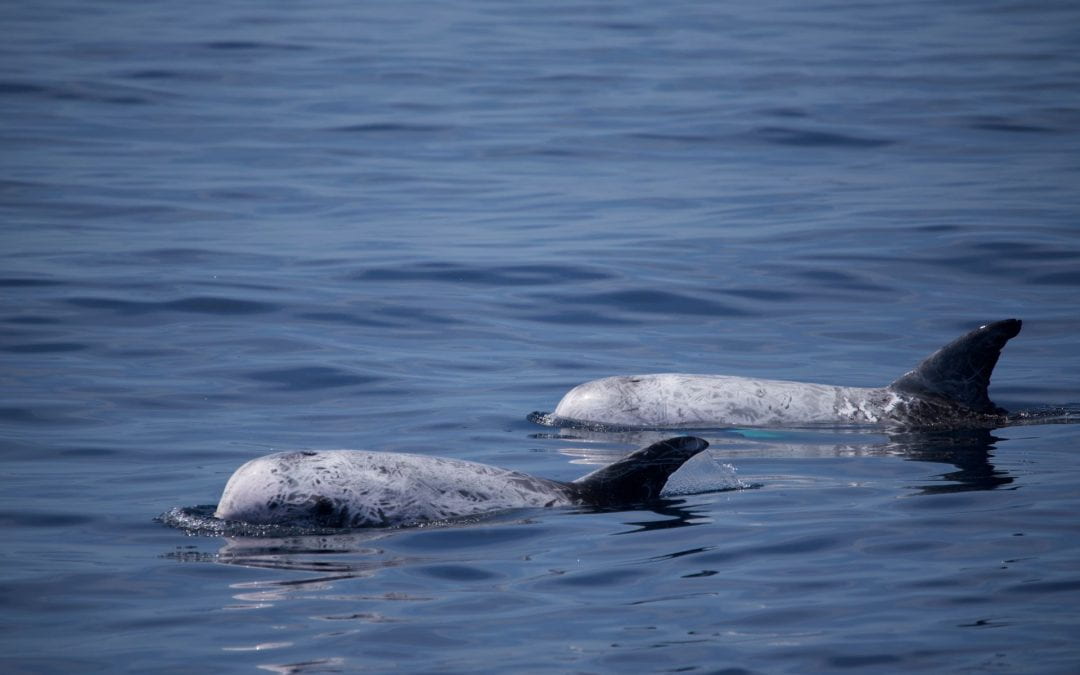Now in the second year of research cruises funded by the New York State Department of Environmental Conservation, researchers from the labs of Drs. Janet Nye, Lesley Thorne and Joe Warren set out this July in an interdisciplinary effort to monitor the physical oceanography, water chemistry, and abundance and distribution of fish and marine mammals in the New York Bight. The cruises are designed to document these variables over a 10-year period and to inform the development of ecosystem indicators in the New York Bight.
As a part of this interdisciplinary work, Thorne lab members are conducting line-transect surveys along 7 transects that cut cross-shelf from nearshore areas to waters several thousand meters deep off the continental shelf break. Static underwater features of the New York Bight area, like the Hudson Canyon, create nutrient rich areas through processes such as upwelling, perfect for supporting the prey species of marine mammals in these areas. Other features, such as the influx of nutrients from the Hudson River and other freshwater inputs, may also drive prey abundance in on shelf waters. Through the collection of concurrent prey and predator data, we are trying to better understand species distribution and seasonality of cetaceans in the New York Bight region.
During the July 2019 research cruise aboard the R/V Seawolf, marine mammal sightings included deep divers off the shelf break and inshore bottlenose dolphins (Tursiops truncatus). The deep diving species that we encountered included a group of pilot whales (Globicephala spp), Risso’s dolphin (Grampus griseus), and Cuvier’s beaked whales (Ziphois cavirostris). In addition to the deep divers, we sighted Atlantic spotted dolphins (Stenella frontalis), short-beaked common dolphins (Delphinus delphis), and some offshore Tursiops off the shelf break and associated with the Hudson Canyon.
The group of Cuvier’s beaked whales was an exciting sighting. PhD student Alex Borowicz sighted a very large, humpback whale breach sized splash from over 1km away in proximity to Spencer Canyon. Researchers at Duke University have shown that Cuvier’s beaked whales off Cape Hatteras generally have fairly short surface interval times (median of 2.2 minutes). Considering the max speed of R/V Seawolf (~9 knots) we were worried that the animals would dive again before we could get to them for photographs. We lucked out and this group was at the surface for ~15 minutes. Photographs of Cuvier’s beaked whales are helpful for sexing the animals as well as identifying individuals with unique dorsal fins or scarring patterns. This particular group contained 2 presumed males, animals with heavy scarring and erupted teach, and 3 “brownies”, or animals with minimal scarring which are presumed to be either juvenile males or females. We are very excited to continue to study these animals during the cruises and photographs from this cruise have already been sent to Andy Read’s lab at Duke to cross reference their photo ID catalogue. No matches were made, but we’re very interested to see the degree of connectivity between these two study locations.

Cuvier’s beaked whale with minimal scarring. Assumed to be a female or juvenile male. Photo: Ellie Heywood
Overall, the observation team is excited about the fact that we are consistently seeing deep divers (pilot whales, Risso’s dolphins, and Cuvier’s beaked whales) in the off-shelf waters of the New York Bight. Considering all of New York’s marine activities and industries (shipping, wind farms, long lining), it is crucial to understand the habitat use, population structure, and predatory-prey dynamics of these species.




